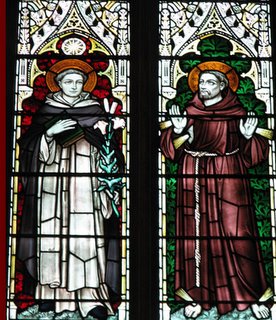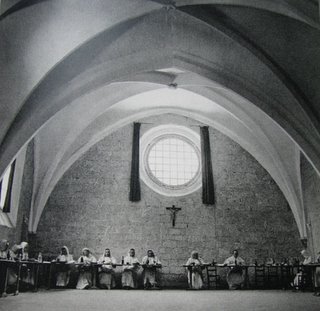Friars in Cambridge
 The mendicant friars of the early 13th century were a new and vibrant form of religious life and it did not take long for them to make their way to Cambridge, which was fast becoming one of the centres of learning in Christendom. They contributed significantly to the theological debate and intellectual life of the university and such luminaries as Dun Scotus are known to have come here.
The mendicant friars of the early 13th century were a new and vibrant form of religious life and it did not take long for them to make their way to Cambridge, which was fast becoming one of the centres of learning in Christendom. They contributed significantly to the theological debate and intellectual life of the university and such luminaries as Dun Scotus are known to have come here.The first to come were the Friars Minor or Franciscans. Known as the Greyfriars, because their habits were woven from a combination of white and black wool, they arrived in 1225, one year after their arrival in England. Their first house was established in the centre of Cambridge and they were helped by the townsfolk and the king in this regard.
These Franciscans were characterised by their spiritual fervour and great poverty. It was noted that they often cried with charismatic joy as they sang the Office and they had no cloaks despite the fact that East Anglia is one of the coldest parts of England. As such the 'Chronicle of Brother Thomas [of Eccleston]' notes that when these pioneering Franciscans were really cold they used to huddle together to keep warm "sicut porcis mos est", in the way that pigs do! Of course, such evangelical fervour, which won such admiration, faded as the Franciscans grew in wealth, learning and prestige!
In 1274, they moved to a new site provided by the townsfolk due to expanding numbers. By 1289, there were 75 Franciscan friars in Cambridge, their highest number ever. The site covered over 3 acres and included a large church, frequently used by the university, a cloister, refectory, two-storey school house and land and an orchard. Nothing remains of all this and Sidney Sussex College now occupies the site of the friary. However, the conduit which provided water to the community, built by the Franciscans in 1325 still provides the water that splashes into the Jacobean fountain in the Great Court of Trinity College.
Next to arrive in Cambridge were the Friars Preachers, possibly around 1238. King Henry III contributed to the building of the new priory and they came to occupy a 10 acre site outside the medieval town of Cambridge, by the Barnwell Gate. At least two stories in the Vitae Fratrum took place in the Cambridge community, which at its height numbered 75 friars.
Called the Blackfriars because they wore the black cappa or cape whenever they walked among the people, outside their priory, there is evidence of a preaching cross or outdoor pulpit where the Dominicans preached to the people of Cambridge. The street where this stood was called Preachers Street but even this trace of the Friars Preachers was obliterated after the Reformation by the change of the name to St Andrew's Street.

There is no evidence of the buildings of the priory as they were so completely destroyed at the Reformation. However, a fish pond remains within the grounds of Emmanuel College, the college which occupies the site of the medieval Dominican priory. Incidentally, on the feast of St Francis of Assisi, Br Paul and I wandered through the grounds of Emmanuel College and we stopped at the fish pond to admire the large fish within. Quite ignorant then of its provenance, I said to Br Paul: "Perhaps this was the friars' pond and they kept their stock of fish here", and I mused on our brothers who had once walked these grounds. I even joked that we should preach to the fish, as St Francis was known to have done. Little did I realize just how accurate I was, for indeed, that is the friars' pond and all that remains of the medieval Dominican Priory of Cambridge which was closed in 1538. Exactly 400 years later, the Priory of St Michael, was established and the Blackfriars returned to Cambridge, the only friars to have done so.
By 1292, the Carmelites or Whitefriars, on account of their white capes which they wore over a brown habit also arrived in Cambridge and they had at their peak no more than 50 friars. They originally had 3 acres of land near Cambridge on the fens, which afforded them a contemplative and semi-eremitical life. However, due to flooding, they found it difficult to travel from Newnham into Cambridge for lectures and so built their house on Milne Street in Cambridge with access to the river Cam. Again, nothing survives of this establishment but their site is now partially occupied by Queens College and extended as far as King's College chapel on the north side.
The Order of the Hermits of St Augustine or the Austin Friars, as they were popularly known, are first mentioned in Cambridge in 1289 and they were given land on the outskirts of Cambridge and housed up to 36 friars. Nothing remains of this friary either although there was
an infirmary which stood until the 18th century.

It was estimated that by the 1300s there were 200 friars in Cambridge and they took part in the religious processions of the town. Interestingly, they always walked in this order and after the secular clergy: Augustinians, Carmelites, Franciscans, Dominicans; this I supposed to be based on the precedence of the Order's foundation. Following the friars in procession were the brothers of St John the Evangelist hospital (now St John's College) and then the university. Of the libraries of the four Orders, only 200 manuscripts were packed at the time of the Dissolution and shipped from Cambridge to Rome but this would have represented a fraction of the total number of volumes.
Sadly so little of the friars and their presence in Cambridge remains, even their precious books dispersed and their buildings obliterated. A few stones believed to be from the original Dominican priory adorn a wall in the cloister of Blackfriars Cambridge (right) but otherwise, it is left to us, the actual Blackfriars who are as spiritual stones, to build upon the foundations laid down by our brethren in the early 13th century.
Co-incidentally, the BBC chose to discuss the rise of the Greyfriars and Blackfriars on BBC Radio 4 yesterday morning! The program hosted by Melvyn Bragg is available online. Great minds think alike!







0 Comments:
Post a Comment
<< Home